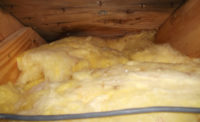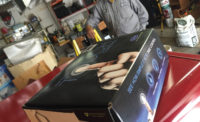Owners and occupants of air conditioned buildings worldwide are burdened with costly property damage and health-threatening conditions caused by omnipresent water inside HVAC systems.
The HVAC system is a well spring of water condensed from circulated air and collected in a drain pan. During cooling operation, water formation is continual and to prevent damage and contamination it must be successively drained away. In most commercial HVAC systems, and many home units, condensate drainage is impeded by negative (below-ambient) pressure. Successful drainage, therefore, requires a special and reliable condensate drain system. When drainage fails, every home and building owner knows the result: damaging overflow, condensate blowing and spreading, and internal contamination.
The condensate drain system is a unique component in the air conditioning system. It is an interface between the air-handler drain pan and the building plumbing system, for which no entity accepts responsibility. There is no approved or laboratory-tested-and-listed drain system.
By default, a drain system with a condensate trap has become the industry standard. The technical and rational basis for its acceptance and endorsement by the HVAC industry is not known. The trap, a key part of this system, exhibits so many failure modes that reliable condensate drainage varies from unlikely to impossible. The numerous trap failure modes, as reported by ASHRAE, are summarized in the sidebar. How these various failures cause damage and threaten health are illustrated in Figure 1.
Only in recent years, with growing national interest in building health and life cycle costs, has the performance of the industry-standard drain system come under technical scrutiny.
Many visits to air conditioned facilities in the U.S. show that failed industry-standard drain systems are causing enormous property damage and creating potentially health-threatening conditions. The photographs in Figures 2, 3, 4, and 5 show failed traps and depict examples of the common and widespread damage and contamination they cause.
Conditions like these are well-known to HVAC service contractors, building owners and managers, designers, and equipment suppliers, yet the conditions are allowed to prevail. Some in the industry who are aware of the conditions described above attribute them to lack of maintenance by the building owner or user. They contend that the only need for successful condensate drainage is a properly designed trap and an adequate maintenance program. However, even considering the best possible trap design, maintenance may not be practical. During cooling operation, a trap cleanout is sometimes required monthly. During non-cooling operation, weekly priming may be necessary. In cold outside locations, traps must be primed with antifreeze. Most building operators and homeowners find the required effort impractical. Even when warned, they frequently fail to act and, instead, tolerate the inevitable failures.
The failure-prone industry-standard drain system gets little attention because no party is responsible for its performance. And, there is no incentive in the industry to solve the problem. In fact, there may be disincentives. Failures add profitable service calls, and equipment suppliers benefit from damaged and shortened equipment life. The only victims are the nonprofessional building owners and occupants.
As justification for specifying and installing trapped drain systems, reference is often made to plumbing code requirements. Codes do require traps on certain drain systems, but that requirement has limits. The widely used International Plumbing Code states requirements for traps are as follows:
• 801.2 Protection — Devices, appurtenances, appliances, and apparatus intended to serve some special function, such as sterilization, distillation, processing, cooling, or storage of ice or foods, and that discharge to the drainage system shall be provided with protection against backflow, flooding, fouling, contamination and stoppage of the drain.
• 1002.3 Prohibited Traps — Traps that depend on moving parts to maintain the seal are probibited.
• 1002.4 Trap Seals — Each fixture trap shall have a liquid seal of not less than 2 inches and not more than 4 inches or deeper, and where a trap seal is subject to loss by evaporation, a trap seal primer valve shall be installed.
SUBJECT TO EVAPORATION
Trapped HVAC drain systems are subject to evaporation in most parts of the U.S., and primer valves have moving parts; accordingly, trapped systems do not satisfy this plumbing code requirement.
Clearly, the widely used industry-standard condensate drain system does not meet the plumbing codes. That observation coupled with the typical failures and consequences illustrated in Figures 2, 3, 4, and 5 show that trapped drain systems are unsuitable for HVAC systems. The photographs show only damage and possible contamination. But, the impact of these conditions on the health of building occupants can be fully appreciated only when it’s realized that all air in a conditioned space passes through the contaminated air handler several times per hour. It also indicates why increased outside ventilating air, which passes through the contaminated air handler, may be less effective than desired or expected.
The need for a proven, effective, and reliable drain system is obvious. In addition to its other effects, it may account for some of the mystery surrounding sick building syndrome, building-related illnesses, and health care-associated infections.
The design, development, and demonstration of a successful drain require commitment, time, and technical effort by the industry, but the requirements are easily defined and are summarized.
ACCEPTABLE DRAIN SYSTEM REQUIREMENTS
• Under all operating conditions, drain systems must:
Allow condensate to drain freely from the drain pan, prevent outside air from being drawn into the unit, and eliminate blowing of condensate from the pan onto internal components.
• Avoid condensate overflow caused by flow blockage or negative pressure;
• Not be affected by algae growth or other debris;
• Not require priming at any time;
• Preclude damage caused by freezing temperatures;
• Have no moving parts;
• Be self-cleaning;
• Require no preventive maintenance; and
• Demonstrate successful field operations for at least 15 years.
A drain system that meets these requirements is available to commercial building owners and homeowners. Simply tell your designer to include these listed requirements in their specifications.
SIDEBAR: ASHRAE Standard 62.89R — 5.6.4: Drains and Drain Pans
Condensate traps exhibit many failure modes that can impact IAQ. Trap failures due to freeze-up, drying out, breakage, blockage, and/or improper installation can compromise the seal against air ingestion through the condensate drain line. Traps with insufficient height between the inlet and outlet on draw-through systems can cause the drain to back up when the fan is on, possibly causing drain pan overflow or water droplet carryover into the duct system. The resulting moist surfaces can become sources of biological contamination. Seasonal variations, such as very dry or cold weather, may adversely affect trap operation and condensate removal.
Publication date: 12/21/2015
Want more HVAC industry news and information? Join The NEWS on Facebook, Twitter, and LinkedIn today!






















